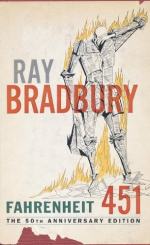|
This section contains 1,439 words (approx. 5 pages at 300 words per page) |

|
SOURCE: "Science Fiction," in Coleridge to Catch-22, St. Martin's Press, 1978, pp. 197-209.
In the following excerpt, Colmer assesses Fahrenheit 451 as a work of social criticism, citing shortcomings in the novel's sentimentality and high-culture allusions.
Fahrenheit 451 takes its place in a long line of works concerned with the survival of language and the written word, since it not only presents a future in which there is constant war or threat of war but one where there is no legitimate place for books. The infamous burning of the books in Nazi Germany provides the historical model for Bradbury's fictional projection. On this model, he imagines a future society in which reading and the possession of books are anti-social activities and therefore must be eradicated.
The curious title is based on the scientific notion that Fahrenheit 451 is 'the temperature at which book-paper catches fire and burns', and the first paragraph of...
|
This section contains 1,439 words (approx. 5 pages at 300 words per page) |

|


